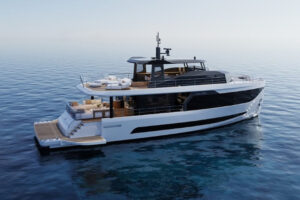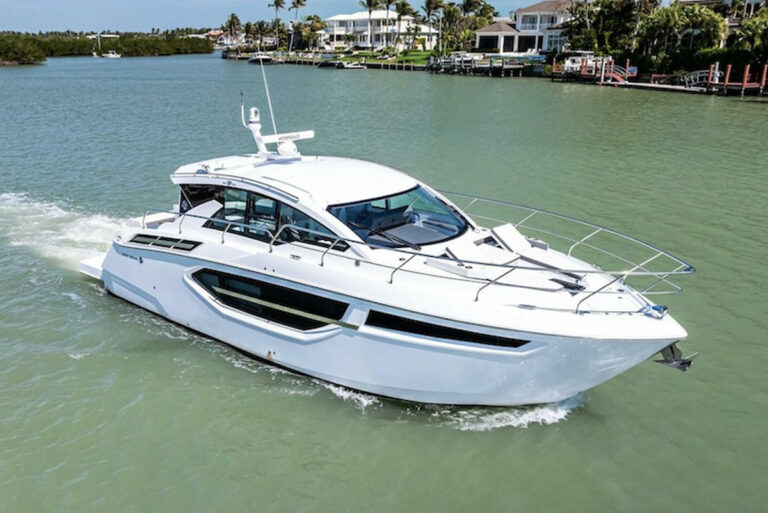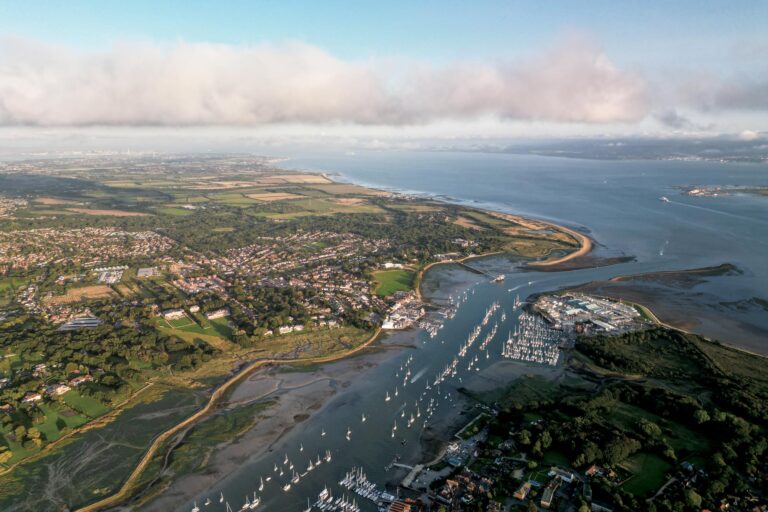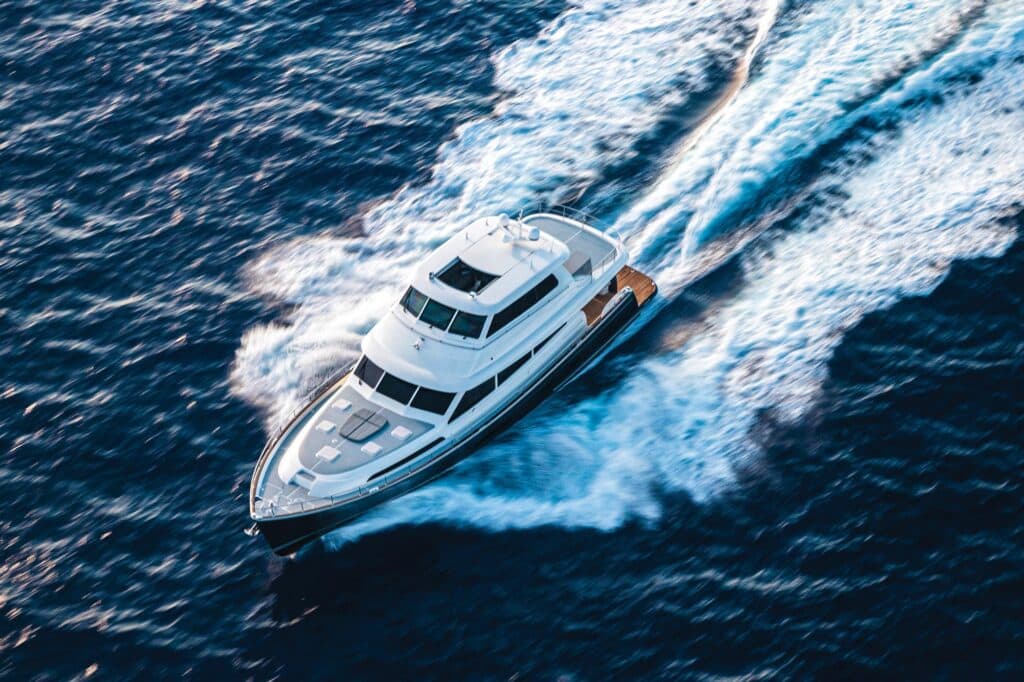
I looked around the flybridge of the Grand Banks 85 Skylounge and counted 14 people as the yacht cruised comfortably at around 21 knots just off the coast of Cannes, France. There was room to spare on this deck inside and out, with an L-shaped lounge, a Vitrifrigo ice maker, and a drawer fridge and freezer creating an alfresco oasis with ocean vistas.
Grand Banks CEO Mark Richards was at the bench-style helm seat forward and to starboard, with a view of three Garmin multifunction displays illustrating all mission-critical data on board the yacht and beyond the bow. He had unobstructed sightlines through three gently raked windows. The sky lounge’s retractable roof was open, the side windows were open, the aft door was open, and the cross breeze coming off the salt was downright balmy.
It was quite a memorable moment as I got to know the Malaysia-based builder’s new flagship. In sheer size and scope, the Grand Banks 85 makes a statement. This yacht comes in at more than 87 feet length overall and displaces 108,000 pounds, with a 22-plus-foot beam and an air draft of just under 26 feet. It’s a formidable cruiser.
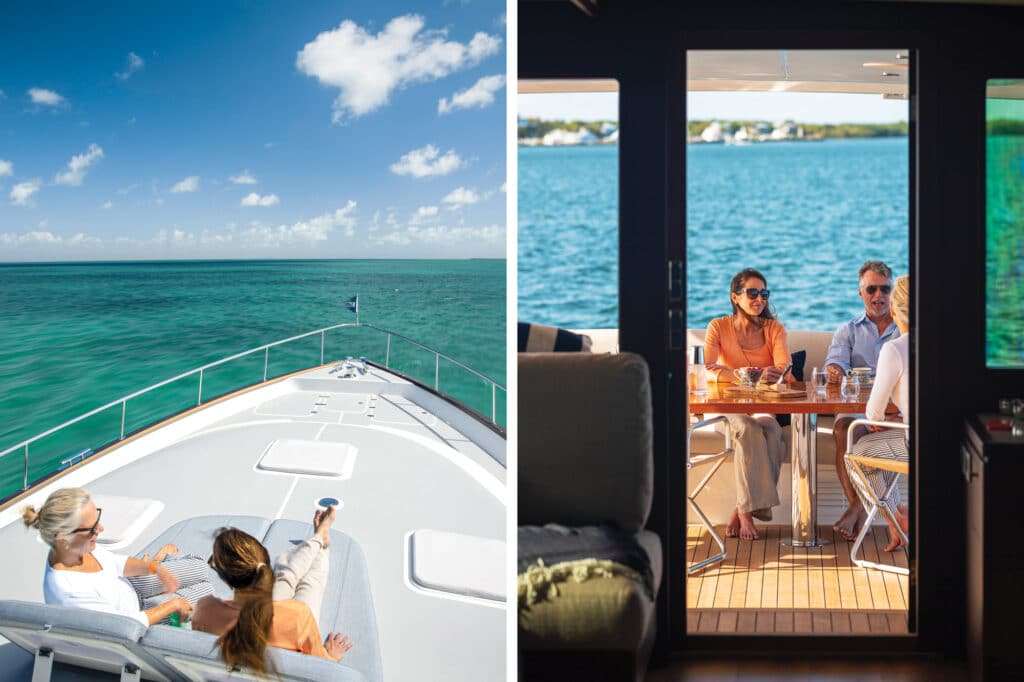
It’s also eminently warm and inviting. The teak-sole cockpit can be accessed by stairs flanking the transom off the full-beam, integral swim platform, which can stow a 14-foot AB Inflatables Alumina tender with a 40 hp outboard. (The tender can also stow aft on the sky-lounge deck, and be launched via davit.) In the cockpit, a bench seat is set against the transom, and loose chairs fill out the alfresco dining area for six or more. The entire area is protected from the elements by the sky-lounge overhang.
A door off the cockpit to port provides access to the salon, where an abundance of glass in the 85 Skylounge’s superstructure creates a bright interior. The salon’s 7-foot headroom enhances the sense of volume. There is a U-shaped settee to starboard, forming a guest conversation nook, with two barrel chairs to port. A walkway to port leads up an 8-inch step from the salon, providing access to the formal dining table for six guests to starboard.
The main-deck interior has a relaxed feeling, created via natural light coming in from the nearly 360 degrees of windows, through indirect lighting, and from the use of satin-finish teak. Standing in the salon, I had an unimpeded view from the cockpit door through the windows forward on the port side.

There’s an open-style, reverse-angled stairway to port, leading to the sky lounge, while a bulkhead forward of the dining space to starboard separates the galley. Since this is a yacht that will likely have crew, the galley is set up for chef-level meal prep with a Miele oven, a four-burner electric cooktop, a Panasonic microwave, a Liebherr fridge and freezer, a Nespresso machine and a nearly 18-inch-deep, pull-out pantry for serious summer-cruising provisions. There is also a docking station located here with side-deck access to starboard via a pantograph door.
Five steps down from the salon and galley is a landing with access to a day head with a shower stall, which is a precursor to the accommodations spaces. Owners can choose from several three- or four-stateroom setups. This owner chose to give up a full-beam master stateroom and instead get an additional stateroom for his grandkids. The layout of this amidships master includes an en suite head to port with his-and-hers sinks. There is also an average 6-foot-9-inch headroom, a 42-inch Sony TV, two closets, a table with seating forward of the berth, and a cleverly concealed piano. (Yes, a piano.)
In the full-beam layout, the head is set abaft the berth, and there is a walk-in closet that’s also abaft the berth, to port.
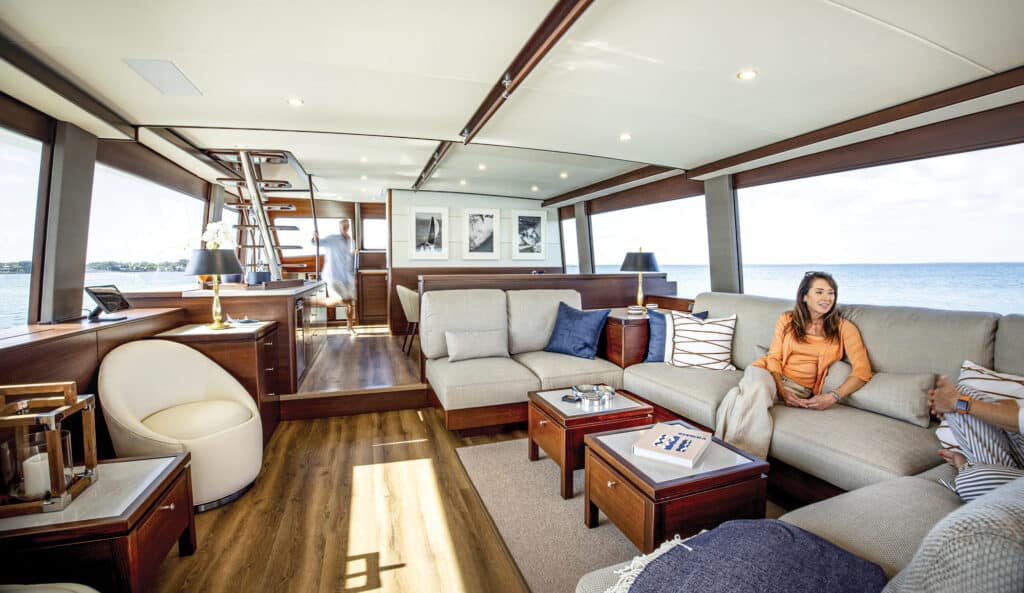
The grandkids’ stateroom—next to the master and to port—has two bunks. There is also a forepeak VIP with an en suite head. Abaft that VIP and to starboard is the fourth guest stateroom, with twin berths and an en suite head.
Two crew cabins, a crew mess, a galley and a head are aft with engine-room access. Owners have choices for engines too: The standard motors are twin 1,000 hp Volvo Penta IPS diesels, but owners can also have twin 1,300 hp MAN straight-shaft diesels. With the larger-engine option, owners can also choose an optional stern thruster, in addition to the standard bow thruster.
Some other notable options include a Seakeeper gyrostabilizer, Victron solar panels for the flybridge hardtop, a passerelle, Garmin electronics, KVH satellite and a 23-bottle wine chiller.
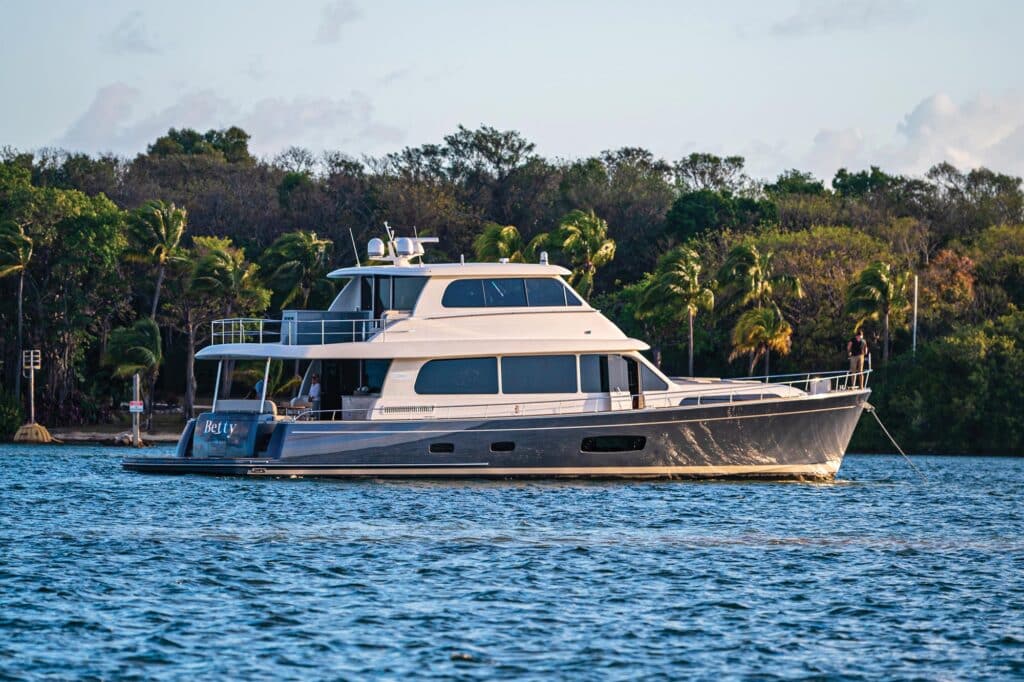
This 85 Skylounge had the IPS diesels, which provide a top hop of 26.5 knots, according to the builder. At top speed, fuel burn is 100 gallons per hour, resulting in a range of 699 nautical miles. At the vessel’s 21-knot cruise speed, fuel consumption drops to 57 gph, and range climbs to 972 nm. At a 9-knot jog, fuel burn falls to 9 gph, and the 85 Skylounge can cruise nonstop for about 2,500 nm.
A timeless exterior design, today’s technology, and a hull form penned for seakindliness, efficiency, comfort and performance make the Grand Banks 85 Skylounge a thoroughly modern yacht ready to take adventurous cruisers waypoint-hopping until they feel like stopping. Or not.
Shallow-Water Access
The Grand Banks has a 4-foot-11-inch draft with Volvo Penta IPS diesels, and a 4-foot-1-inch draft with straight-shaft MANs. In either scenario, the yacht is primed for the Bahamas, cruising and exploring with the ability to access most anywhere an owner may want to go. This is a great trawler for the island hopper.
Built for Blue Water
The Grand Banks 85 Skylounge has an infused, foam-cored, E-glass hull, with the deck and superstructure built via infused carbon fiber. According to the builder, all bulkheads and furniture are also structurally bonded to the hull, enhancing overall strength even further.
The Range
The 85 Skylounge is Grand Banks’ largest model, but the builder also offers 54- and 60-foot flybridge or sky-lounge yachts, as well as 44- and 60-foot Eastbay express cruisers. All these models run on the same V-warp hull form.
Serious Seakeeping
Under CEO Mark Richards, Grand Banks has implemented its patented V-warp semidisplacement hull design across its fleet, including this 85-footer. Starting with a fine entry, the deadrise transitions with notable flare amidships, which helps “roll water away” from the hull’s surface. Farther aft, the deadrise reduces to 6 to 8 degrees, adding stability and lift, and resulting in a vessel with little to no bow rise when throttling up. The hull design also enhances overall performance and efficiency, and leaves a flat wake.
Take the next step: grandbanks.com


